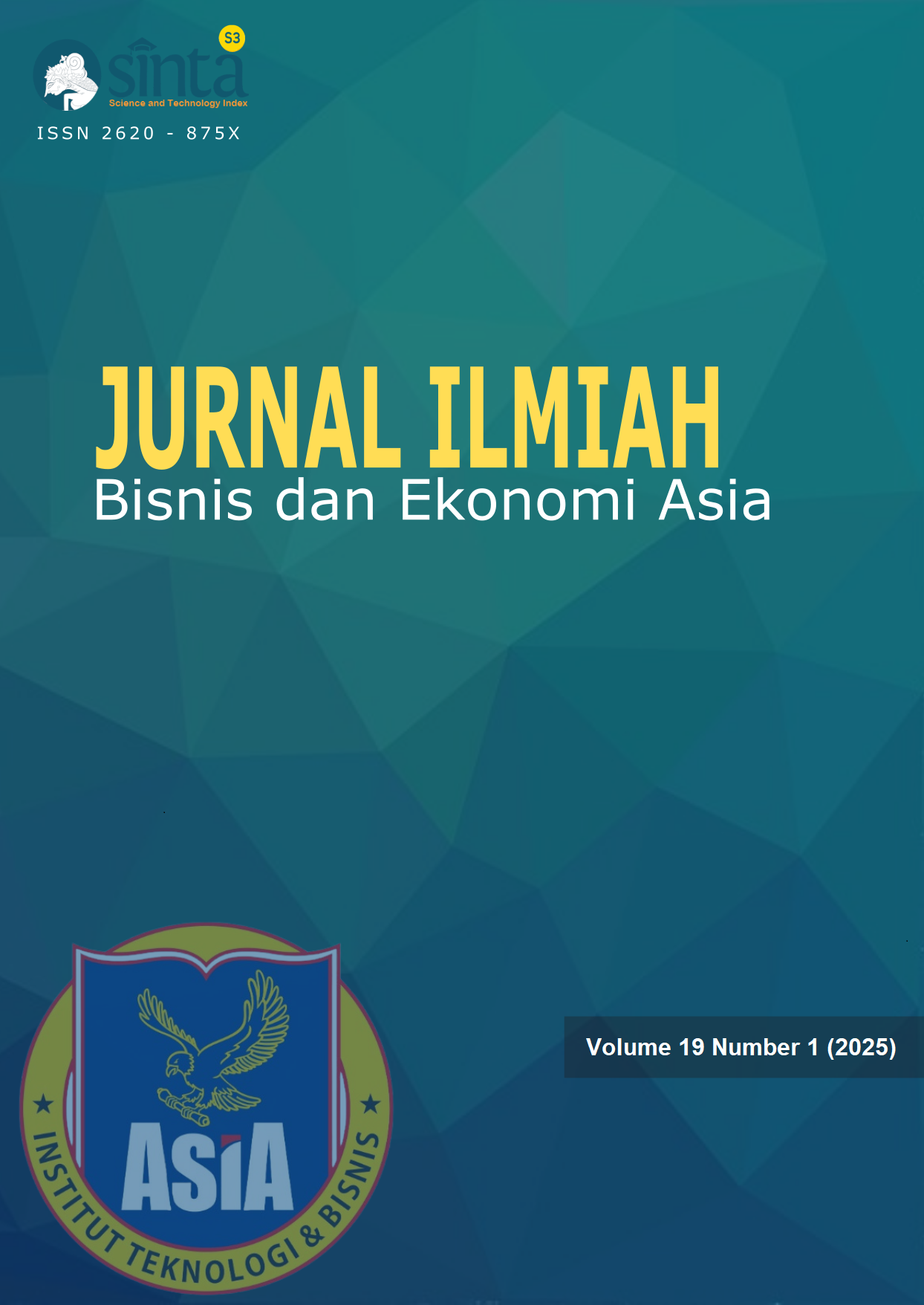Trust, Financial Literacy and Investment Intention
A Case in Securities Crowdfunding Platform using Trust Transfer Theory
DOI:
https://doi.org/10.32815/jibeka.v19i1.2348Keywords:
Investment, Securities Crowdfunding, Financial Literacy, TrustArticle Metrics
Abstract
This study aims to reveal the role of trust in mediating the effect of financial literacy on investment intentions on the securities crowdfunding platform. The research method used is quantitative with a survey approach, using purposive sampling technique, with a total of 180 investors. Data were analyzed using Partial Least Squares (PLS-SEM). The results showed that financial literacy significantly affects investment intention and trust in the securities crowdfunding platform. In addition, trust in the platform also plays an important role in increasing trust in the fundraiser. This study concludes that financial literacy and trust in the platform have a significant impact on investors' intention to invest, and support the application of Trust Transfer Theory in the context of securities crowdfunding.
Downloads
References
Adil, M., Singh, Y., & Ansari, Mohd. S. (2022). How Financial Literacy Moderate the Association Between Behaviour Biases and Investment Decision? Asian Journal of Accounting Research, 7(1), 17–30. https://doi.org/10.1108/AJAR-09-2020-0086
Alharbey, M., & Hemmen, S. V. (2021). Investor Intention in Equity Crowdfunding. Does Trust Matter? Journal of Risk and Financial Management, 14(2), 53–53. https://doi.org/10.3390/jrfm14020053
Aren, S., & Nayman Hamamci, H. (2023). Evaluation of Investment Preference with Phantasy, Emotional Intelligence, Confidence, Trust, Financial Literacy and Risk Preference. Kybernetes, 52(12), 6203–6231. https://doi.org/10.1108/K-01-2022-0014
Brown, S. J., Veld, C., & Veld-Merkoulova, Y. V. (2017). Why do Individuals not Participate in The Stock Market? SSRN Electronic Journal. https://doi.org/10.2139/ssrn.2822094
Bunyamin, M., & Abdul Wahab, N. (2022). Impact of Financial Literacy on Finance and Economy: A Literature Review. Labuan Bulletin of International Business and Finance (LBIBF), 20(2), 49–65. https://doi.org/10.51200/lbibf.v20i2.3677
Chen, D., Lai, F., & Lin, Z. (2014). A Trust Model for Online Peer-To-Peer Lending: A Lender’s Perspective. Information Technology and Management, 15(4), 239–254. https://doi.org/10.1007/s10799-014-0187-z
Hair, J. F., Hult, G. T. M., Ringle, C. M., & Sarstedt, M. (2022). A Primer on Partial Least Squares Structural Equation Modeling (PLS-SEM) (Third edition). SAGE.
Hair, J. F., Risher, J. J., Sarstedt, M., & Ringle, C. M. (2019). When to use and how to report the results of PLS-SEM. European Business Review, 31(1), 2–24. https://doi.org/10.1108/EBR-11-2018-0203
Hidayatullah, H., Hariyanto, D., & Safitri, H. (2022). Analysis of Financial Literacy and Financial Behavior on Stock Investment Decisions: A Case Study of Students of the Faculty of Economics and Business, University of Muhammadiyah Pontianak. Journal of Economics, Finance and Accounting Studies, 4(4), 74–81. https://doi.org/10.32996/jefas.2022.4.4.9
Jihan Nadra Arifah & Zuliani Dalimunthe. (2021). The Impact of Financial Literacy on the Investment Decision of Non-Donation-Based Crowdfunding in Indonesia. International Journal of Business and Society, 21(3), 1045–1057. https://doi.org/10.33736/ijbs.3310.2020
Kim, M. J., Hall, C. M., & Kim, D.-K. (2020). Why do Investors Participate in Tourism Incentive Crowdfunding? The Effects of Attribution and Trust on Willingness to Fund. Journal of Travel & Tourism Marketing, 37(2), 141–154. https://doi.org/10.1080/10548408.2020.1722784
Kou, G., Olgu Akdeniz, Ö., Dinçer, H., & Yüksel, S. (2021). Fintech Investments in European Banks: A Hybrid IT2 Fuzzy Multidimensional Decision-Making Approach. Financial Innovation, 7(1), 39. https://doi.org/10.1186/s40854-021-00256-y
Le, T.-L., Abakah, E. J. A., & Tiwari, A. K. (2021). Time and Frequency Domain Connectedness and Spill-Over Among Fintech, Green Bonds and Cryptocurrencies in the Age of the Fourth Industrial Revolution. Technological Forecasting and Social Change, 162, 120382. https://doi.org/10.1016/j.techfore.2020.120382
Liang, T.-P., Wu, S. P.-J., & Huang, C. (2019). Why Funders Invest in Crowdfunding Projects: Role of Trust From the Dual-Process Perspective. Information & Management, 56(1), 70–84. https://doi.org/10.1016/j.im.2018.07.002
Malhotra, N. K. (2007). Marketing research: An Applied Orientation (5th ed). Pearson/Prentice Hall.
Mufidah, A., Istifadah, I., & Nurul Awaliyah, I. (2022). Sharia Financial Literacy in Personal Financial Planning. International Social Sciences and Humanities, 1(2), 198–203. https://doi.org/10.32528/issh.v1i2.174
Ningtyas, M. N. (2019). Literasi Keuangan pada Generasi Milenial. Jurnal Ilmiah Bisnis Dan Ekonomi Asia, 13(1), 20–27. https://doi.org/10.32812/jibeka.v13i1.111
Ningtyas, M. N. (2024). Financial Literacy, Financial Attitudes, and The Environment on Investment Decisions Through Investment Intention. 7(2).
Pfister, J. A., Peda, P., & Otley, D. (2023). A methodological framework for theoretical explanation in performance management and management control systems research. Qualitative Research in Accounting & Management, 20(2), 201–228. https://doi.org/10.1108/QRAM-10-2021-0193
Raut, R. K., Das, N., & Kumar, R. (2018). Extending the Theory of Planned Behaviour: Impact of Past Behavioural Biases on the Investment Decision of Indian Investors. Asian Journal of Business and Accounting, 11(1), 265–291. https://doi.org/10.22452/ajba.vol11no1.9
Riwayati, H. E., Cahaya, Y. F., & Markonah, M. (2023). Financial Literacy’s Influence on Investment Decisions. GATR Accounting and Finance Review, 8(1), 27–35. https://doi.org/10.35609/afr.2023.8.1(1)
Stewart, K. J. (2003). Trust Transfer on the World Wide Web. Organization Science, 14(1), 5–17. https://doi.org/10.1287/orsc.14.1.5.12810
Vuk, K., Pifar, A., & Aleksić, D. (2017). Should I, Would I, Could I: Trust and Risk Influences on Intention to Invest. Dynamic Relationships Management Journal, 6(1). https://doi.org/10.17708/DRMJ.2017.v06n01a06
Downloads
Published
How to Cite
Issue
Section
License
Copyright (c) 2025 Ulfa Nahdhiroh, Mega Noerman Ningtyas

This work is licensed under a Creative Commons Attribution-ShareAlike 4.0 International License.
Happy reading. Do not forget to cite. Thank you.








